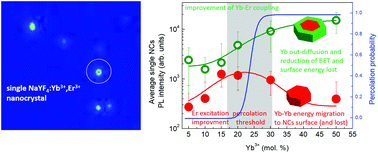Percolation limited emission intensity from upconverting NaYF4:Yb3+,Er3+ nanocrystals – a single nanocrystal optical study†
Abstract
Upconverting nanocrystals (UCNC) have recently been subjected to intensive investigation due to their interesting optical properties and high potential for practical applications. Despite the level of attention paid to these materials, very low quantum yield is still an important issue. In order to break through this limitation, understanding of the emission intensity limitation is crucial. In this paper, we investigate the influence of percolation phenomena on the limitation of the emission intensity from NaYF4:Yb3+,Er3+ nanocrystals. We propose a numerical model and support this experimentally at the single nanocrystal level, explaining the influence of Yb3+ concentration on the optical properties of UCNC. Moreover, based on the experimental and numerical results, we explain the existence of the optimal Yb3+ concentration in the core architecture often reported in the literature. All the measurements have been performed using a custom-built wide-field fluorescence microscope to analyze the emission from hundreds of single nanocrystals and thus make analysis independent of UCNC concentration.



 Please wait while we load your content...
Please wait while we load your content...